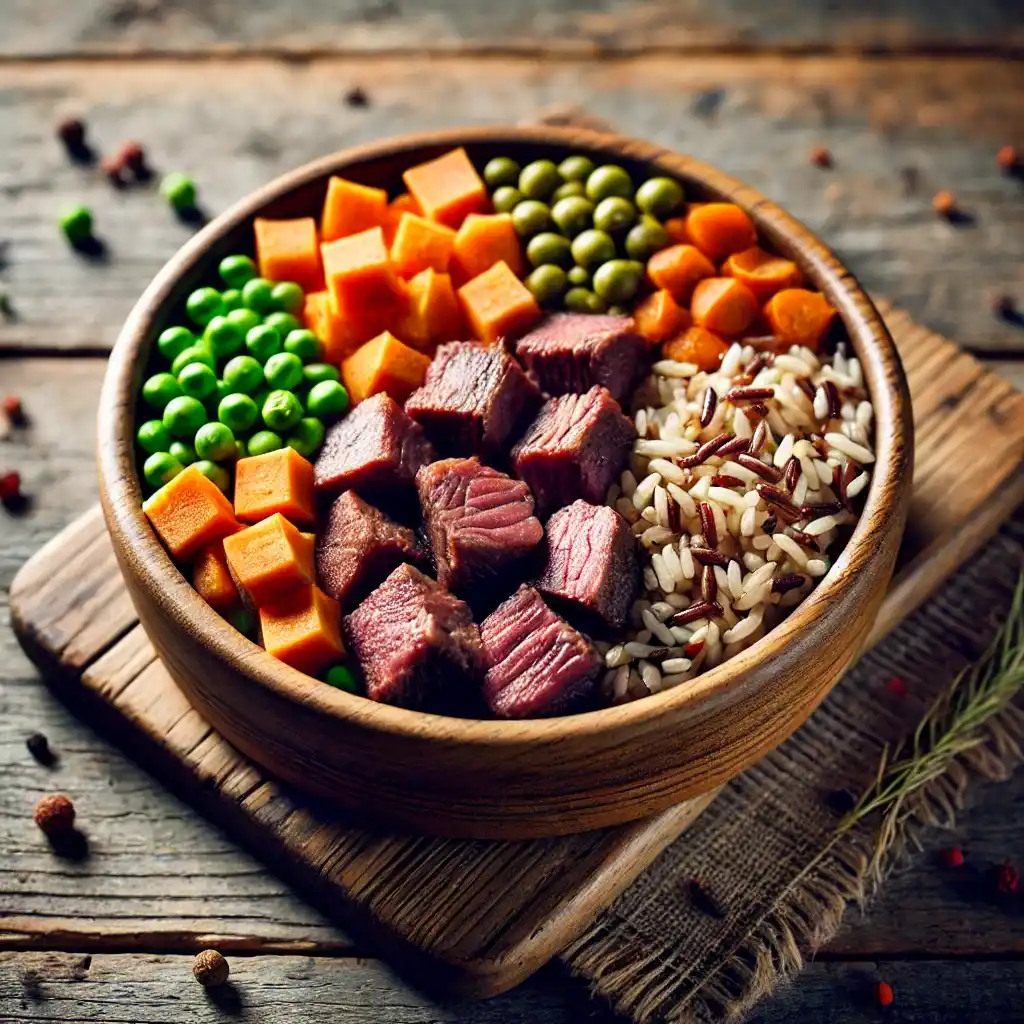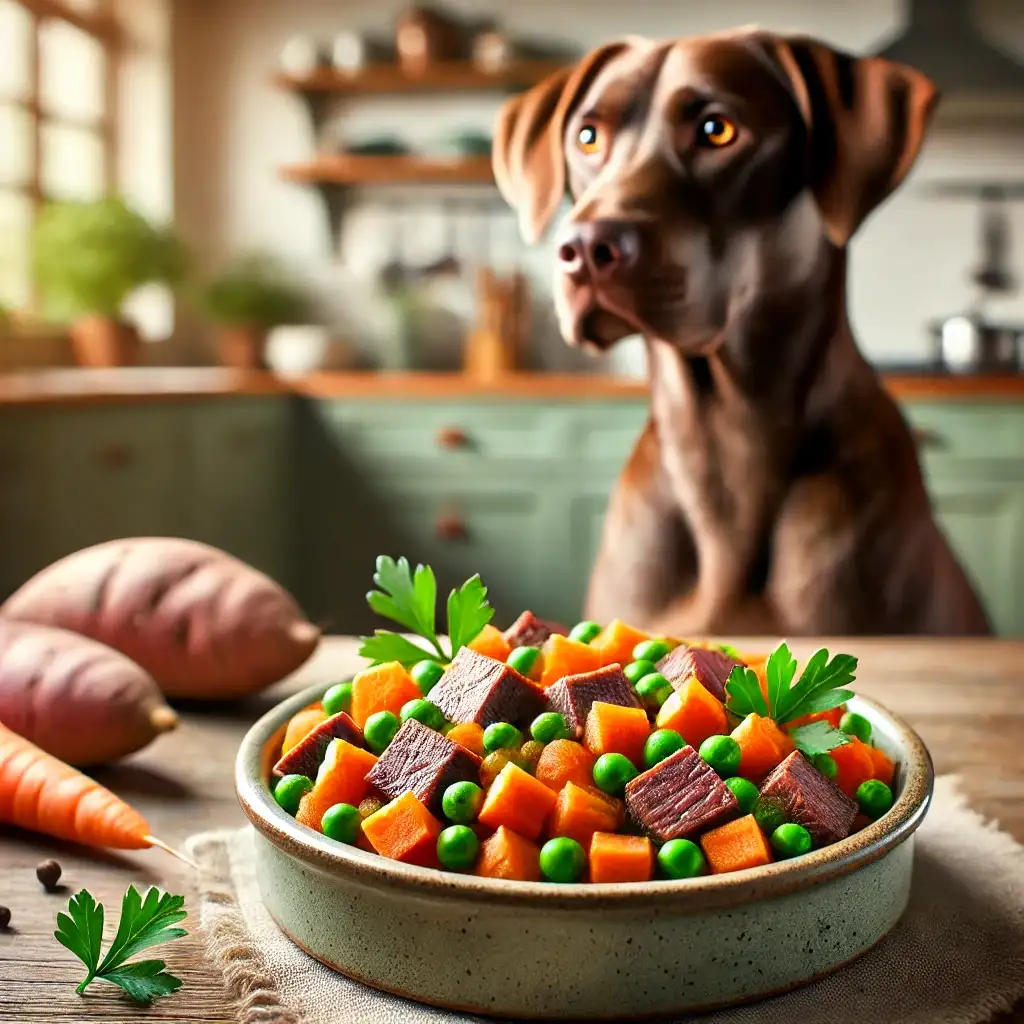If you’re looking for a healthy and delicious homemade dog food recipe, venison might just be the perfect protein for your pup. Not only is venison lean and packed with essential nutrients, but it’s also a great alternative for dogs with allergies to common proteins like chicken or beef. Today, I’m excited to share my ultimate venison dog food recipe, along with tips to make it nutritious and tailored to your dog’s needs.
Why Choose Venison for Your Dog?
Venison is a powerhouse protein that offers several benefits for dogs:
- High-quality protein: Venison provides essential amino acids to support muscle development and maintenance.
- Low-fat content: It’s leaner than beef, making it an excellent choice for dogs needing weight management.
- Rich in vitamins and minerals: Venison is packed with iron, zinc, and B vitamins, which contribute to overall health.
- Novel protein: For dogs with food sensitivities or allergies, venison can be a great hypoallergenic option.
Ingredients for the Venison Dog Food Recipe
Here’s what you’ll need to prepare this wholesome meal:
Main Ingredients:
| Ingredient | Quantity |
|---|---|
| Ground venison | 2 pounds |
| Sweet potatoes (cubed) | 2 cups |
| Brown rice (cooked) | 1 cup |
| Carrots (diced) | 1 cup |
| Green beans (chopped) | 1 cup |
| Spinach (chopped) | 1 cup |
Additional Supplements:
| Supplement | Quantity |
| Fish oil | 1 teaspoon |
| Calcium supplement powder | As directed |
| Coconut oil | 1 tablespoon |
Step-by-Step Cooking Instructions
Follow these simple steps to prepare a hearty venison meal for your dog:
1. Prepare the Ingredients
- Wash and chop all the vegetables (sweet potatoes, carrots, green beans, and spinach) into bite-sized pieces.
- Prepare the brown rice as directed on the packaging.
2. Cook the Venison
- Heat a large skillet over medium heat.
- Add the ground venison and cook until fully browned. Drain any excess fat if necessary.
3. Boil the Vegetables
- Bring a large pot of water to a rolling boil.
- Add the sweet potatoes and carrots. Cook for about 10 minutes or until tender.
- Add the green beans and spinach in the last 2 minutes of boiling.
4. Combine Ingredients
- In a large mixing bowl, combine the cooked venison, vegetables, and brown rice.
- Stir in the fish oil, calcium supplement powder, and coconut oil for added nutrients.
5. Cool and Serve
- Allow the mixture to cool fully before serving it to your dog.
- Store leftovers in an airtight container in the refrigerator for up to 5 days.
Nutritional Information
Here’s a breakdown of the nutrients in this venison dog food recipe:
| Nutrient | Benefit |
| Protein (Venison) | Builds and repairs muscles. |
| Carbohydrates (Rice) | Provides energy for active dogs. |
| Fiber (Sweet Potatoes) | Supports digestion and promotes gut health. |
| Vitamins (Carrots/Spinach) | Boosts the immune system and supports the vision. |
| Omega-3 (Fish Oil) | Promotes a shiny coat and reduces inflammation. |
| Calcium | Strengthens bones and teeth. |

Tips for Customizing the Recipe
Every dog is unique, so you can tweak this recipe to suit your pet’s needs:
- For weight management: Reduce the amount of rice and increase the spinach or green beans.
- For picky eaters: Add a small amount of unsalted chicken broth for extra flavor.
- For grain-free diets: Swap the brown rice for quinoa or eliminate grains entirely.
Storage and Serving Suggestions
- Storage: Divide the cooked food into meal-sized portions. Freeze them for up to 3 months in airtight containers or freezer bags.
- Serving size: The amount depends on your dog’s weight, age, and activity level. As a general guideline, feed approximately 1 cup per 25 pounds of body weight per day.
Why Make Homemade Dog Food?
Preparing meals at home gives you complete control over your dog’s nutrition. Commercial dog foods often contain fillers, preservatives, and low-quality ingredients. By cooking for your dog, you can:
- Ensure high-quality, fresh ingredients.
- Customize the recipe for allergies or special dietary needs.
- Strengthen the bond with your furry friend through thoughtful care.
A Few Words of Caution
- Consult your vet: Before switching your dog’s diet, consult a veterinarian to ensure it meets your dog’s nutritional requirements.
- Introduce gradually: Transition to homemade food slowly by mixing it with their current food.
- Avoid harmful ingredients: Never include onions, garlic, chocolate, or other toxic foods in your dog’s meals.
Final Thoughts
Venison dog food is a healthy, tasty option for your furry companion, especially if they have sensitivities to traditional proteins. By making this recipe at home, you’re not just providing a nutritious meal but also showing your dog how much you care. Try this recipe and watch your pup wag their tail with joy!
Frequently Asked Questions
1. Is venison a good protein source for dogs?
Yes, venison is an excellent protein source for dogs. It is lean, rich in essential amino acids, and a great alternative for dogs with sensitivities to common proteins like chicken or beef.
2. Can dogs with food allergies eat venison?
Venison is often recommended for dogs with food allergies because it’s a novel protein for many dogs, reducing the likelihood of triggering allergies.
3. What other ingredients pair well with venison in homemade dog food?
Venison pairs well with ingredients like brown rice, sweet potatoes, carrots, peas, spinach, and healthy fats like fish oil.
4. How should venison be cooked for dogs?
Venison should be thoroughly cooked to kill any potential parasites or bacteria. Avoid adding seasonings, salt, or spices, as these can be harmful to dogs.
5. Can I feed my dog raw venison?
Feeding raw venison is possible but comes with risks, such as bacterial contamination or parasites. If feeding raw, ensure it is high-quality meat sourced from a trusted supplier.
6. How much venison dog food should I feed my dog?
The amount depends on your dog’s size, weight, activity level, and age. A general guideline is 2-3% of their body weight per day, divided into meals. Consult your vet for personalized advice.
7. Can I freeze venison dog food for later use?
Yes, venison dog food can be frozen for up to 2-3 months in airtight containers or freezer bags. Thaw it in the refrigerator before serving.
8. Is venison too lean for dogs?
While venison is lean, it’s important to balance the meal with healthy fats like coconut oil, fish oil, or flaxseed oil to meet your dog’s dietary fat requirements.
9. Are there any risks of feeding venison to dogs?
Ensure the venison is free of bones, seasoning, and preservatives. Also, make sure it’s properly cooked to avoid risks like parasites or bacteria.
10. Can I use venison from hunting in dog food?
Yes, but make sure the venison is processed and stored safely. Remove bones and check for potential contaminants like lead from bullets. Cook thoroughly before feeding.
11. How do I ensure the recipe is nutritionally balanced?
Use a variety of ingredients like grains, vegetables, and fats, and consider adding supplements like calcium or a canine multivitamin. Consulting with a vet or pet nutritionist is highly recommended.
12. Can puppies eat venison dog food?
Yes, but ensure the recipe is formulated for a puppy’s nutritional needs, including higher protein and calorie content. Always consult your vet before introducing homemade meals to puppies.

